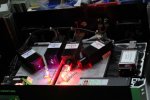jors
0
- Joined
- May 9, 2014
- Messages
- 79
- Points
- 18
Hi all!
Want to build high power rgb laser.
I've find several ways to combining multiple beams, say, knife edge & beam splitter techniques (once).
but... for example please take a look at KVANT 30w rgb:
http://p.globalsources.com/IMAGES/PDT/SPEC/785/K1072773785.pdf
How they obtain, for instance, 10W/445nm?? knife edge here?
Awesome20Laser20-2020wattstechnics_.jpg Photo by magicmushrooms1 | Photobucket
the same for Red module: 10W/637+660nm etc
Any ideas about technique they use?
Many thanks!!
Jordi
Want to build high power rgb laser.
I've find several ways to combining multiple beams, say, knife edge & beam splitter techniques (once).
but... for example please take a look at KVANT 30w rgb:
http://p.globalsources.com/IMAGES/PDT/SPEC/785/K1072773785.pdf
How they obtain, for instance, 10W/445nm?? knife edge here?
Awesome20Laser20-2020wattstechnics_.jpg Photo by magicmushrooms1 | Photobucket
the same for Red module: 10W/637+660nm etc
Any ideas about technique they use?
Many thanks!!
Jordi




